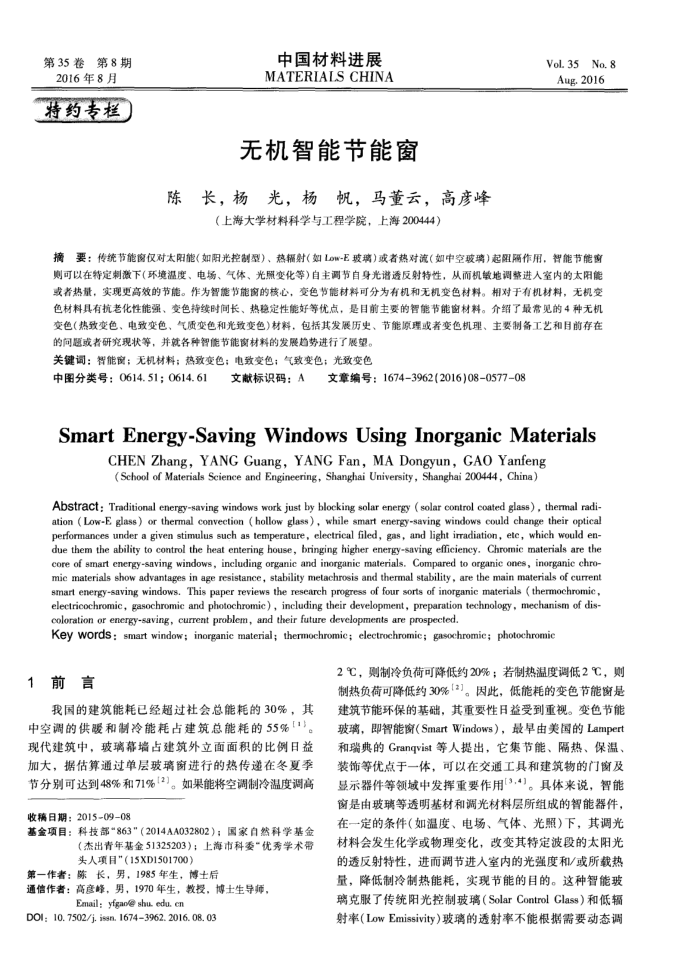内容简介
 第35卷第8期 2016年8月
第35卷第8期 2016年8月特约专栏
中国材料进展 MATERIALSCHINA
无机智能节能窗
陈长,杨光,杨帆,马董云,高彦峰
(上海大学材料科学与工程学院,上海200444)
Vol.35
5No.8 Aug.2016
摘要:传统节能窗仅对太阳能(如阳光控制型)、热辐射(如Low-E玻璃)或者热对流(如中空玻璃)起阻隔作用,智能节能窗则可以在特定刺激下(环境温度、电场、气体、光照变化等)自主调节自身光谱透反射特性,从而机敏地调整进人室内的太阳能或者热量,实现更高效的节能。作为智能节能窗的核心,变色节能材料可分为有机和无机变色材料。相对于有机材料,无机变色材料具有抗老化性能强、变色持续时间长、热稳定性能好等优点,是目前主要的智能节能窗材料。介绍了最常见的4种无机交色(热致变色、电致变色、气质变色和光效变色)材料,包括其发展历史、节能原理或著变色机理、主要制备工艺和目前存在
的间题或者研究现状等,并就各种智能节能窗材料的发展趋势进行了展望。关键调:智能窗;无机材料;热致变色;电致变色;气致变色;光致变色
中图分类号:0614.51;0614.61
文献标识码:A
文章编号:1674-3962(2016)08-0577-08
Smart Energy-SavingWindows Using InorganicMaterials
CHENZhang,YANGGuang,YANGFan,MADongyun,GAOYanfeng(School of Materials Science and Engineering, Shanghai University, Shanghai 200444, China)
Abstract: Traditional energy-saving windows work just by blocking solar energy (solar control coated glass), thermal radi-ation (Low-E glass) or thermal convection (hollow glass), while smart energy-saving windows could change their optical performances under a given stimulus such as temperature, electrical filed, gas, and light iradiation, etc, which would en-due them the ability to control the heat entering house, bringing higher energy-saving efficiency. Chromic materials are the core of smart energy-saving windows, including organic and inorganic materials, Compared to organic ones, inorganic chro mic materials show advantages in age resistance, stability metachrosis and thermal stability, are the main materials of current smart energy-saving windows. This paper reviews the research progress of four sorts of inorganic materials ( thermochromic, electricochromic, gasochromic and photochromic) , including their development, preparation technology, mechanism of dis-coloration or energy-saving, current problem, and their future developments are prospected.
Key wordS: smart window; inorganic material; thermochromic; electrochromic; gasochromie; photochromic
1前言
我国的建筑能耗已经超过社会总能耗的30%,其中空调的供暖和制冷能耗占建筑总能耗的55%【1]。现代建筑中,玻璃幕墙占建筑外立面面积的比例日益加大,据估算通过单层玻璃窗进行的热传递在冬夏季节分别可达到48%和71%2]。如果能将空调制冷温度调高
收稿日期:2015-09-08
基金项目:科技部“863"(2014AA032802);国家白然科学基金
(杰出青年基金51325203);上海市科委优秀学术带头人项目(15XD1501700)
第一作者:陈长,男,1985年生,博士后
通信作者:高意峰,男,1970年生,教投,博士生导师
Email; yfgao@ shu edu. cn
DOI: 10. 7502/j. issn. 16743962. 2016. 08. 03
2℃,则制冷负荷可降低约20%;若制热温度调低2℃,则制热负荷可降低约30%【2]。因此,低能耗的变色节能窗是建筑节能环保的基础,其重要性日益受到重视。变色节能玻璃,即智能窗(SmartWindows),最早由美国的Lampert 和瑞典的Granqvist等人提出,它集节能、隔热、保温、装饰等优点于一体,可以在交通工具和建筑物的门窗及显示器件等领域中发挥重要作用[3,4]。具体来说,智能窗是由玻璃等透明基材和调光材料层所组成的智能器件,在一定的条件(如温度、电场、气体、光照)下,其调光材料会发生化学或物理变化,改变其特定波段的太阳光的透反射特性,进而调节进入室内的光强度和/或所载热量,降低制冷制热能耗,实现节能的目的。这种智能玻璃克服了传统阳光控制玻璃(SolarControlClass)和低辐射率(LowEmissivity)玻璃的透射率不能根据需要动态调
上一章:特种功能材料中的固态相变及应用
下一章:制备工艺对NaFeB磁体力学性能的影响